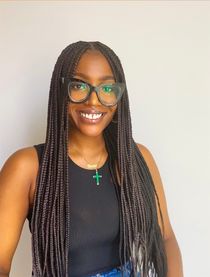Body

Ad
Somewhere between the start of the pandemic and entering the late stages of my 20s, bras become less and less of a priority.
Within that span of time, I, like most of the world, spent my days inhabiting my small bubble, staying in the house with loose-fitting loungewear, and being on Zoom calls that only required me to be presentable from the neck up. So as the demand to have my breasts at their perkiest form, so did my commitment to wearing bras.
The relationship that most women have with their bras is… well, complicated. While society has led us to believe that they’re required for us to be deemed as “ladylike” and “neat,” many of us find the garment to be a bothersome (and optional) accessory at best.
From underwires that poke and dig at our sides to push-ups that spill over, the argument in support of bras has begun to wane over the last few decades, with women of all cup sizes asking themselves if it’s better to just go braless.

Courtesy of Harper Wilde
“Many years ago, I ditched wired bras and opted for going braless out of a desire for freedom and celebrating natural human form,” multi-hyphenate Alyson Stoner tells xoNecole. The movement activist best known for their fly dance moves with the likes of Missy Elliott and on Step Up 2: The Streets, shares that when it comes to their bra selection, comfort is key. “As someone who enjoys moving their body, I found that I do want an underlayer that provides some support without interfering with comfort and mobility.”
A source of concern when choosing to go braless is whether or not the lack of support from a bra will, in turn, affect the firmness of one’s breast, resulting in early sagging. However, Sabrina Sahni, M.D., an oncologist at Mayo Clinic in Florida, shares that breast sagging is a result of age, not whether you’ve ditched your bras.
“Sagging breasts – also called ptosis – generally occurs due to chronic aging,” she tells xoNecole. “The breast is made up of a combination of glandular and fibrous tissue and fat tissue. Over time, the glandular tissue may become replaced with fattier tissue, and that can lead to more sagging. Wearing a bra or not wearing a bra ultimately does not change that.”
"Wearing a bra or not wearing a bra ultimately does not change that."
Women with heavier breasts may find that going braless may have its set of drawbacks, but Dr. Sahni says that you should always pay attention to your comfort levels since bras are a garment designed to support your back and correct your posture. “Those with heavier or larger breasts who choose to go braless may actually have worsening back/neck/shoulder pain,” she says. “Wearing a bra may allow them to correct their posture and help alleviate tension on those muscle groups.”
“Women with larger breasts may benefit from wearing a well-fitted, supportive bra as it may alleviate things like upper back pain or neck pain,” she shares.
Listening to your body is key when choosing whether you want to toss out your bras forever or just for a day. The beauty in a woman’s body is that it will tell us what we need to know before we even have to ask. There are common misconceptions about tighter bras being linked to causing health issues like breast cancer.
And while studies do show that Black women are “twice as likely to be diagnosed with breast cancer early when compared with Caucasian women,” the manifestation of this disease is predetermined by other varying factors.
“There are a lot of myths out there about going braless being better for breast cancer risk. It is completely false,” Dr. Sahni explains. “Whether or not you wear a bra does not have any bearing on your overall breast cancer risk. Ultimately, your risk is dependent on a variety of factors, including family history, your breast density, your lifestyle, and your reproductive history.”
If you’re looking for classic, weightless comfort that’s close to going braless, Alyson Stoner recommends Harper Wilde, a body-inclusive intimates brand on a mission to create a more comfortable world for womankind. They currently have a capsule collection with the intimates brand in partnership with their company, Movement Genius.
“Harper Wilde has been my go-to for years now because the materials are truly soothing on my sensitive skin, the amount of support feels like you're being gently hugged (not squeezed), and the styles are flattering and beautiful enough to wear as shirts or visible layers,” they say.
Courtesy of Harper Wilde
The brand offers super soft, breathable cotton fabric in their Triangle and Scoop Bralettes ($40 each) that will put the bliss and comfort back in your bosom.
Dr. Sahni says that choosing to opt out of bras or keep them close to your chest “truly depends on the individual” but it should be understood that “wearing or not wearing a bra won't significantly impact your overall health.”
“Ultimately, it comes down to comfort. There are some women with chronic breast pain where perhaps changing their bras to something more supportive and well-fitted may help,” she says. “Alternatively, some women find that going bra-less will alleviate their breast pain. I tell women that they should choose a bra that is comfortable for them, feels supportive, and one that they can wear regularly.”
So whether you choose to free the tatas or wear a bra that feels like it’s barely there, remember to listen to your body because ultimately, the choice is yours.
Let’s make things inbox official! Sign up for the xoNecole newsletter for daily love, wellness, career, and exclusive content delivered straight to your inbox.
Featured image by Delmaine Donson/Getty Images
From Your Site Articles
Related Articles Around the Web
ALSO ON XONECOLE


